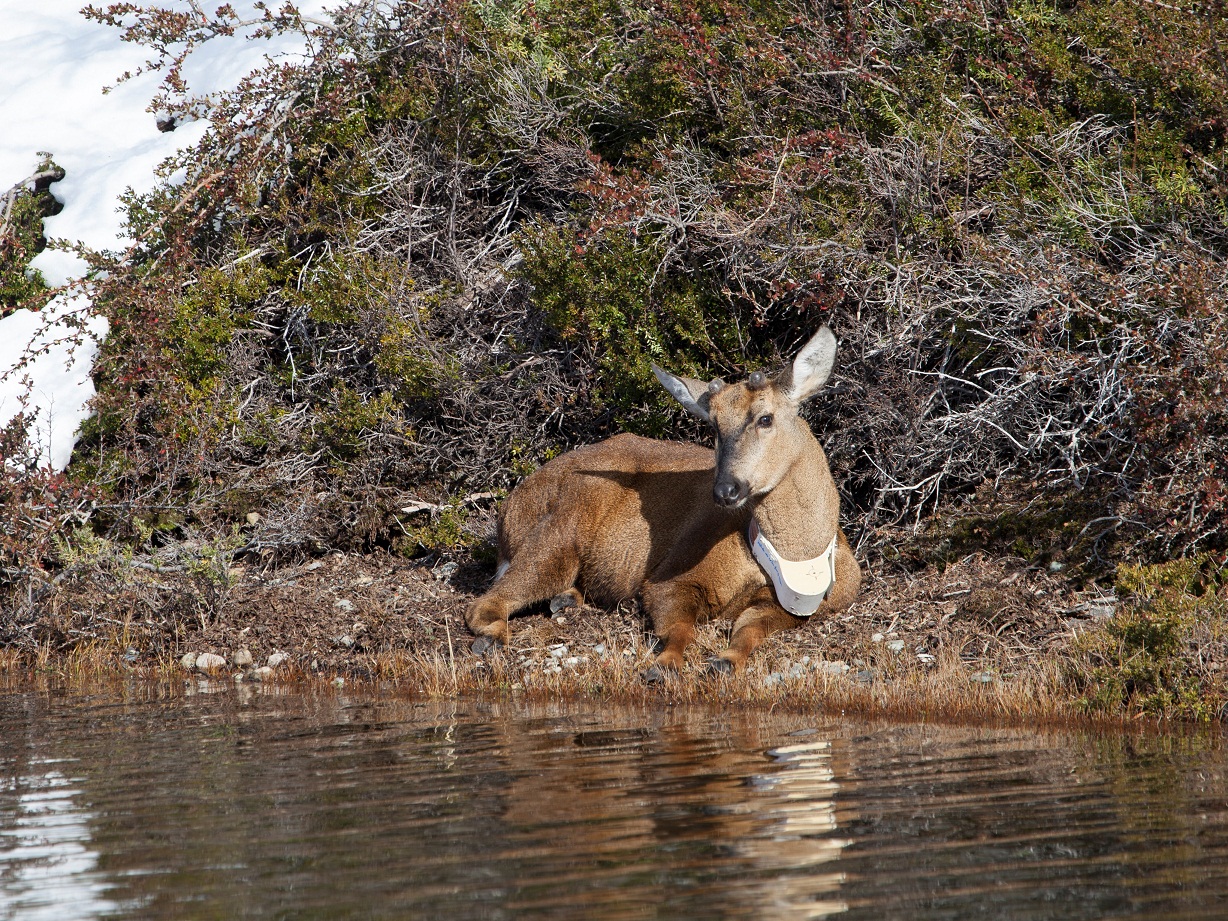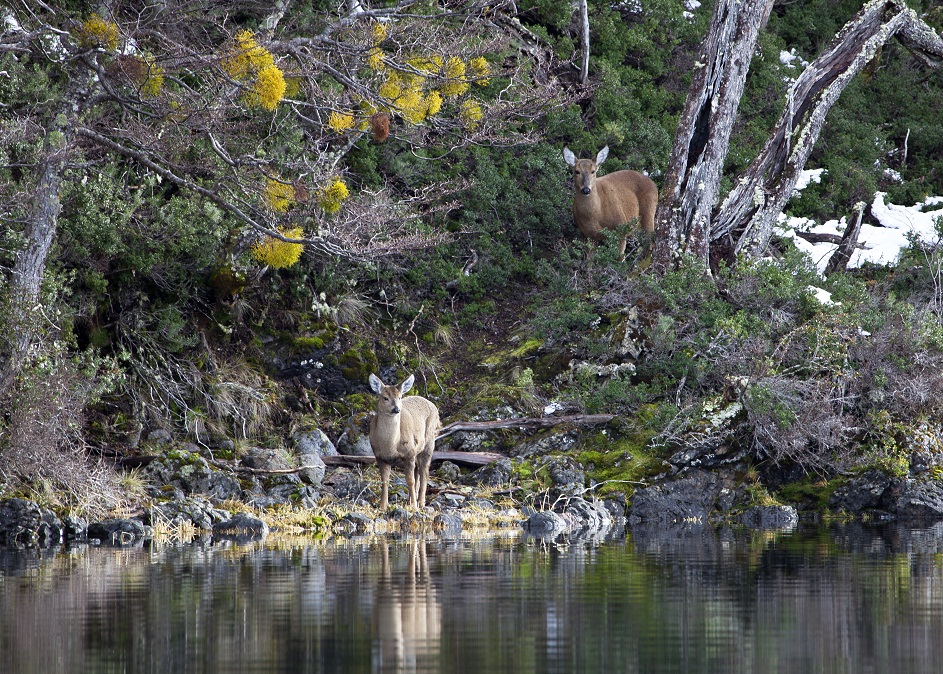"To preserve the Watershed of the Senguer River, Province of Chubut - Argentina, particularly aimed at recovering the endangered Patagonian Huemul deer."
Our Mission

The main mission of this Project is to cooperate with the preservation and conservation of natural resources in the Senguer River Basin, Chubut, Argentina by furthering management and scientific investigation projects applied to nature conservation; promoting Sustainable Development through environmental education and multimedia-based dissemination of scientific knowledge. The goals pursued are as follows:
a) Foster conservation of the endangered Patagonian Huemul deer
b) assist the village Alto Rio Senguer in the management of their Protected Park Shoonem
c) Promote scientific, conservation and management activities in the Rio Senguer Basin
d) Disseminate scientific knowledge through audiovisual media, and published material
e) Participate in training sessions, both formally and informally, aiming at strengthening humankind's relationship with nature.
Trajectory of Science and Applied Technology
Objective: Population Recovery of the Endangered Patagonian Huemul Deer
1.1 Conservation Center for Rehabilitation and Breeding of Huemul:
The goal is to construct this first and only such center in Argentina. It is a semi-captive enclosure of 110 ha located in natural habitat, near the lake Fontana and already approved by authorities: Department of Flora and Wildlife, Ministry of Production, Province of Chubut. The mission include to stabilize the adverse health condition in wild populations endangered of extinction, in the area of Lago Fontana and Lago la Plata, and to repopulate areas which have been used historically using animals born in the Center. Funds are needed to advance with structural issues, like construction materials, management sheds, bridges, road improvements, special fencing, living and laboratory spaces, and qualified personnel.
1.2 Equipment and Scientific Investigations:
Funds are destined for tools and equipment used in studies of the biology and ecology of ungulates in the wild and in the Center. The aim is to acquire new radio collars with modern GPS technology, equipement for video and photographic documentation of the sceintific work, tranquilizer drugs and medications, repeated laboratory analyses. Also needed are general instruments like refrigerator, centrifuge, for surgery, portable ecograph, transportation unit for live animals, camera traps for monitoring, radios for communication, and mobility.
1.3 Specialization and Knowledge Transfer:
The aim is to allow continuous capacitation of the technical/scientific personnel involved, publications, presentations in congresses/symposia/conferences, and multimedia diffusion. It would also include the formation of a geographical information system to analyze and present the generated environmental information, in a continuous flow of events. There a need for periodic encounters to exchange information by various specialized institutions, aimed at improving the Management Plans of the Protected Park Shoonem in Argentina, and the neighboring National Park Lago las Torres in Chile, as well as the aim to form a future binational Biosphere Reserve (program of MAB/Unesco). This line would also assist students (masters and doctoral) to accomplish their research projects about the ecology and conservation of huemul.
1.4 Management Plan for the Protected Park Shoonem
It is a progressive process embodied in a technical document that integrates the environmentally responsible actors of a territory: citizens, institutions, organizations, producers, and enforcement authorities. This program funds environmental studies that favor informed discussions; they are linked to the management of the ecotonal territory (favorable habitat previous used by huemul), lake ecology, water basin dynamics, monitoring of the climatic gradient to produce data bases, population dynamics of introduced exotics: wild boar, red deer, rainbow and fontinalis trout, pines and other plant species. There are striking occurrences such as the increased predation of the native forest by the insect cuncuna, and other ecology dilemmas in general.
Trajectory of Reinforcing the newly created Protected Park Shoonem

Objective: Provide the Operational Infrastructure to the Park
2.1 Mountain Refuges:
The aim is to construct several mountain refuges in sites facilitating Park management and control of visitors, the monitoring of huemul, and the control of illegal cattle, mainly from Chile. The refuges would be built using steel framing, sanitary units, and some with facilities for mountaineers using peripheral trails in the Park. It is anticipated that the Park will interact with the National Gendarme groups who are responsible for national border issues.
2.2 Center of Operation and Capacitation:
A new center had been built for the new Park, but unfortunately was completely destroyed by fire. Shortly after, another large building had been loaned officially to the Foundation Shoonem. It has not been finished according to original plans, and therefore remained unused. Funds would be used to finish the living quarters such that will provide living accommodation for park wardens, scientists, students, and visitors. It also provides space for stationing the boat of the Foundation, vehicles, workshop, library etc, or to organize training courses or conferences.
2.3 Access portals marking the entry to the Park, and informative poster shields:
The access to the Protected park Shoonem is by 2 provincial roads (Nr. 21 South and Nr. 57 North), which are the only terrestrial accesses. The aim is to have well-built entrances of good esthetic and informative quality for visitors, and to allow controlling illegal hunting movements and introduction of undesirable pests and exotic species. To that effect there need to be a cabin for permanent personnel, at least for the seasons of higher activities, and facilities to disinfect incoming boats, transport of livestock, and vehicles in general.
Trajectory of Transference

Objective: Socialize the Scientific and Technological Information
3.1 Training of Park Wardens and Work Internships:
Together with the village Alto Río Senguer it will finance the temporal personnel and assist with the capacitation of young volunteers like graduates of the middle level. The aim is to look for volunteers from foreign countries and have them work with people from this watershed, to enrich the experience and facilitate multicultural interactions. The capacitation is modular and obligatory, and there will be certificates for such capacitations.
3.2 Environmental Interpretation for the Formal Education in the Region:
There will be an educative offer for villages in this watershed: Alto Río Senguer, Comodoro Rivadavia, Sarmiento, Rada Tilly, Caleta Olivia, Facundo, Río Mayo, Aldea Beleiro, Ricardo Rojas, El Chalía, Lago Blanco, José de San Martín, Gobernador Costa. This will include the generation of thematic instructives, guided visits and camping for teachers and students.
